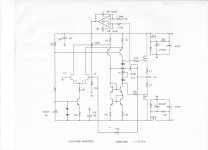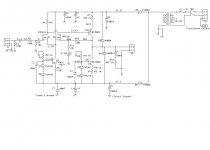Thanks John, I'm going to try experimenting with the alternative topology you posted. I will try them with some 2SK880 and see what I can do with it.
MOSFETs like IRF510/IRF9520 are also good for input stages. They have to be biased at 35 - 40mA then (each). They are even more RFI resistant than JFETs, and probably even better at this position, for power amplifiers.
I generally use IRF610 and IRFP510 devices of output followers or cascodes. For common source amplifiers, these devices have to be at least Harris (Fairchild) for the P's. Hitachi devices like the 2SK214, 2SJ76 work OK too.
The 'complementary' argument is sort of weak. It is not that true complementary devices would not be desired, but the lack of true complementary parts usually just means a bit more 2'nd harmonic. It must be remembered that usually the complementary part is working WITH the other part, not just being a parasite, just drawing current (at minimum) or even adding to the load, AND as well having a complementary distortion curve as well.
John, have you tried complementary double emitter followers instead of mosfets (for a line amp op stage) or even diamond buffer? They sound better to me.
Mosfets sound better to you?😕I have tried just about everything. '-)
MOSFETs like IRF510/IRF9520 are also good for input stages. They have to be biased at 35 - 40mA then (each). They are even more RFI resistant than JFETs, and probably even better at this position, for power amplifiers.
This is a circuit we let students build.
Attachments
It would appear that just showing schematics does little to encourage progress. This is understandable, but a bit of a problem.
The problem is: Can I convey what the DIFFERENCE between the schematics is, in terms of audio design excellence? With so many believing that virtually everything reasonably well made, sounds effectively the same, why not just switch to IC's and forgo the hassle of getting parts, making boards, wiring and testing? It can be done for us at the factory, with BETTER SPECS as well.
The problem is: Can I convey what the DIFFERENCE between the schematics is, in terms of audio design excellence? With so many believing that virtually everything reasonably well made, sounds effectively the same, why not just switch to IC's and forgo the hassle of getting parts, making boards, wiring and testing? It can be done for us at the factory, with BETTER SPECS as well.
...why not just switch to IC's and forgo the hassle of getting parts, making boards, wiring and testing? It can be done for us at the factory, with BETTER SPECS as well.
Because of the peculiarities of the fashion niche market?
I don't know, SY. Most of what I buy from others is IC based. My Sony FM tuner, the OPPO 105, the VCR/DVD burner, etc. Why do I find that I need more? Perhaps, I don't.
Of course, the same argument was made about tubes, decades ago. Why go through all that wasted heat, dangerous high voltage, and the 'wear out' characteristic of tubes, when we can get everything with solid state?
Yet, I still like the sound of the BEST tube electronics, perhaps over my own solid state designs. I'm sure that the reassuring glow of the tubes is the secret. '-)
Yet, I still like the sound of the BEST tube electronics, perhaps over my own solid state designs. I'm sure that the reassuring glow of the tubes is the secret. '-)
It would appear that just showing schematics does little to encourage progress. This is understandable, but a bit of a problem.
The problem is: Can I convey what the DIFFERENCE between the schematics is, in terms of audio design excellence? With so many believing that virtually everything reasonably well made, sounds effectively the same, why not just switch to IC's and forgo the hassle of getting parts, making boards, wiring and testing? It can be done for us at the factory, with BETTER SPECS as well.
John,
I am dumb and learning. I am more than willing to listen to you explanation of the resistor arrangement. I have the simplified version sitting in eagle cad, on hold, as I want to see the benefits of this arrangement.
Yet, I still like the sound of the BEST tube electronics, perhaps over my own solid state designs. I'm sure that the reassuring glow of the tubes is the secret. '-)
For me the reason is the SPEED at which the signal travels through them.
1 nS (transit time in a vacuum tube) is not all that fast. Whether its an issue is open to question. I would posit that the microphonics of tubes enhances the reality and space heard when using a thermionic device with as much authority.
Demian do you recall the interview with KOJ in TAS? It was many years ago and I probably have the issue in storage, rather buried away.1 nS (transit time in a vacuum tube) is not all that fast. Whether its an issue is open to question. I would posit that the microphonics of tubes enhances the reality and space heard when using a thermionic device with as much authority.
Keith speculated on some of the reasons tubes could sound good, and I recall among them was the larger number of charge carriers compared to solid state devices.
Brad
Buzzforb, you are asking a question that has an almost arbitrary answer. There are many ways to bias the fets. Usually we do the simplest approach.
Of course, the same argument was made about tubes, decades ago. Why go through all that wasted heat, dangerous high voltage, and the 'wear out' characteristic of tubes, when we can get everything with solid state?
Yet, I still like the sound of the BEST tube electronics, perhaps over my own solid state designs. I'm sure that the reassuring glow of the tubes is the secret. '-)
Hi John,
This is a very interesting topic for me. I set out a few years ago ( perhaps naively ) to try and design a solid state power amp that would encompass many of the musical qualities of well designed valve amp without losing the benefits of solid state.
Recently I was able to make a comparison with a friends DIY 300B SET.
At the time the valve amp was reproducing instruments with a little more natural timbre than my SS design - but there wasn't that much in it and thus encouraged I have done various mods to attempt to close that gap and I'm quite encouraged with the results thus far.
Now, I think it's time get a reality check against the very best out there 🙂
I'm wondering what amps, either solid state or valve, that I could find here in the UK, do you think are the ones I should be comparing with.
I'm thinking Audionote & Ayre for starters and I'm told I should check out a SIT amp but I'm sure there are others out there I don't know about and would appreciate hearing your thoughts on this. Also not sure what hi end designs of yours might be available here.
cheers
mike
- Status
- Not open for further replies.
- Home
- Member Areas
- The Lounge
- John Curl's Blowtorch preamplifier part II


